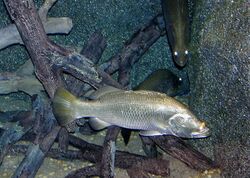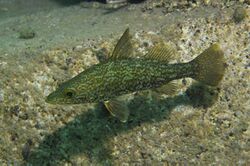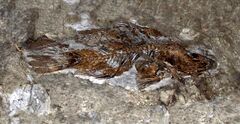Biology:Lates
| Lates | |
|---|---|

| |
| Barramundi (L. calcarifer) displaying eyeshine | |
| Scientific classification | |
| Domain: | Eukaryota |
| Kingdom: | Animalia |
| Phylum: | Chordata |
| Class: | Actinopterygii |
| Order: | Perciformes |
| Family: | Latidae |
| Genus: | Lates G. Cuvier, 1828 |
| Type species | |
| Lates niloticus Linnaeus, 1758[3]
| |
| Synonyms[4] | |
| |
Lates is a genus of freshwater and euryhaline lates perches belonging to the family Latidae. The generic name is also used as a common name, lates, for many of the species.[5]
All species are predatory, and the Nile perch (L. niloticus), in particular, has become infamous as an invasive species introduced into the East African Lake Victoria, where many native Haplochromines were driven extinct. In contrast to the widespread Barramundi and Nile perch (though the fish does face threats from human activity), several members of the genus Lates with relatively restricted African or Asian distributions are themselves considered threatened.
Etymology
The generic name Lates derives from the Latin latēre (to be hidden).
Description
These fishes range in size from less than 30 to 200 cm (1 to 7 ft) in maximum overall length, the largest species reaching weights up to 200 kg (440 lb).[5] They all have the characteristic centropomid shape, with the two-part dorsal fin and general percoid form.
All species are carnivorous, preying on aquatic invertebrates and other fish in a wide variety of habitats.
Distribution and habitat
These fishes are native to freshwater and marine waters of Africa, Asia, the Indian Ocean, and the western Pacific Ocean. Several species are endemic to the Rift Valley lakes in Africa.
Species
Currently, 11 recognized species are placed in this genus:[5]
- Lates angustifrons Boulenger, 1906 (Tanganyika lates)
- Lates calcarifer (Bloch, 1790) (barramundi)
- Lates japonicus Katayama & Y. Taki, 1984 (Japanese lates) (Japanese barramundi)
- Lates lakdiva Pethiyagoda & A. C. Gill, 2012
- Lates longispinis Worthington, 1932 (Rudolf lates)
- Lates macrophthalmus Worthington, 1929 (Albert lates)
- Lates mariae Steindachner, 1909 (bigeye lates)
- Lates microlepis Boulenger, 1898 (forktail lates)
- Lates niloticus (Linnaeus, 1758) (Nile perch)
- Lates stappersii (Boulenger, 1914) (sleek lates)
- Lates uwisara Pethiyagoda & A. C. Gill, 2012
Extinct species
Extinct species within this genus include:[1]
- †Lates gibbus Agassiz 1833
- †Lates gracilis Agassiz 1833
- †Lates macrurus Agassiz 1833
- †Lates noteus Agassiz 1833
- †Lates qatraniensis Murray and Attia 2004
Extinct species within this genus lived from the Eocene epoch to recent, beginning around 37.2 million years ago. Fossils have been found in Africa (Libya, Egypt, Kenya, Tunisia, Chad, Uganda, the Democratic Republic of the Congo, Niger, and Sudan), Saudi Arabia, and Slovakia.[1]
References
- ↑ 1.0 1.1 1.2 "Lates Cuvier 1828 (lates)". http://www.fossilworks.org/cgi-bin/bridge.pl?a=taxonInfo&taxon_no=131417#.
- ↑ Murray,A.M., Attia,Y.S. A new species of Lates (Teleostei: Perciformes) from the Lower Oligocene of Egypt, Journal of Vertebrate Paleontology, 2004, 24(2):299–308
- ↑ Eschmeyer, William N.; Fricke, Ron; van der Laan, Richard, eds. "Lates". California Academy of Sciences. http://researcharchive.calacademy.org/research/ichthyology/catalog/fishcatget.asp?genid=1113.
- ↑ Eschmeyer, William N.; Fricke, Ron; van der Laan, Richard, eds. "Genera in the family Latidae". California Academy of Sciences. http://researcharchive.calacademy.org/research/ichthyology/catalog/fishcatget.asp?tbl=genus&family=Latidae.
- ↑ 5.0 5.1 5.2 Froese, Rainer and Pauly, Daniel, eds. (2013). Species of Lates in FishBase. October 2013 version.
Wikidata ☰ Q787185 entry
 |




